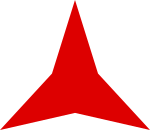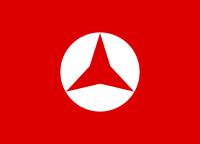Popular Front (Spain) facts for kids
Quick facts for kids
Popular Front
Frente Popular
|
|
|---|---|
 |
|
| Leader | Manuel Azaña |
| Founded | January 1936 |
| Dissolved | 1939 |
| Ideology | Progressivism Republicanism Secularism Anti-fascism Internal factions: • Communism • Socialism • Liberalism • Liberal radicalism • Social liberalism • Social democracy • Anarcho-syndicalism |
| Political position | Left-wing Internal factions: Centre-left to far-left |
| Colors | Red |
| Party flag | |
 |
|
The Popular Front (called Frente Popular in Spanish) was a group of different left-wing political parties in Spain. They joined together in January 1936 to win an election. This happened during Spain's Second Spanish Republic.
In some parts of Spain, like Catalonia, this group was known as Front d'Esquerres, which means "Front of the Lefts".
The Popular Front included several important parties. These were the Spanish Socialist Workers' Party (PSOE) and the Communist Party of Spain (PCE). It also had republican parties like Republican Left (led by Manuel Azaña) and Republican Union.
Other groups also supported the Popular Front. These included Galician and Catalan nationalist parties. Big worker unions like the Workers' General Union (UGT) and the CNT also gave their support. Some anarchists, who later fought in the Spanish Civil War, did not vote for them in the election.
In 1935, a group called the Communist International suggested that different left-wing parties should team up. This was to fight against the rise of Fascism. In Spain, the Popular Front aimed to protect social changes made by an earlier government. They also wanted to free people who had been put in prison after a big workers' strike in 1934.
The Popular Front won the 1936 election. They beat a group of right-wing parties. After their win, Manuel Azaña became the President of Spain in May 1936.
However, in July 1936, some conservative generals started a military takeover. This event began the terrible Spanish Civil War (1936–1939). The government gave weapons to armed groups of workers and party members. These groups managed to stop the rebel forces in some big cities like Madrid and Barcelona. But after a long and difficult war, General Francisco Franco won. He then ruled Spain as a dictatorship until he died in 1975.
Contents
History of the Popular Front
How the Popular Front Started
The Popular Front was created in 1936. It was a team of different left-wing parties. They wrote a special document called a manifesto. This document explained what they stood for.
The manifesto said that the previous conservative government had done some bad things. It demanded that political prisoners be set free. It also asked for government workers who were unfairly fired to get their jobs back. The Popular Front wanted judges to be independent from the government. They also wanted to protect people's rights from unfair police actions. The manifesto focused on being fair and moderate, not extreme.
What the Popular Front Wanted to Do
The Popular Front wanted to help the economy. They did not want the government to take over all the land. Instead, they wanted to help farmers with money and new laws. They also supported protecting Spanish industries. This meant making it harder for foreign goods to compete. They promised to help small businesses and build more public projects. They also wanted to make taxes fairer, so richer people paid more.
The manifesto also promised to bring back laws that gave more power to different regions of Spain. These laws had been removed by the previous government. The Popular Front said they wanted a republic where everyone had freedom, not just certain social classes. They also promised to increase wages for farmworkers.
Members of the Popular Front
The main groups that were part of the Popular Front were:
- Spanish Socialist Workers' Party – A party that believed in Socialism.
- Communist Party of Spain – A party that believed in Communism.
- Workers' Party of Marxist Unification – A party with Libertarian Marxist ideas.
- Syndicalist Party – A party that believed in Syndicalism.
- Republican Left – A party that believed in a republic.
- Republican Union – Another party that believed in a republic.
These groups also had support from:
- Republican Left of Catalonia – A party that supported Catalan nationalism.
- Galicianist Party – A party that supported Galician nationalism.
- Workers' General Union – A big Socialist trade union.
- CNT-FAI – A Anarcho-syndicalist trade union.
The 1936 Election and What Happened Next
In the 1936 Spanish election, the Popular Front won. Their leader, Manuel Azaña, became the President of Spain. The Popular Front received more votes than the right-wing parties. They won 278 seats in the government.
Many of the people elected from the Popular Front were educated professionals. Some even came from wealthy families. After the election, the Popular Front kept its promise. They rehired workers who had been fired for political reasons. They also paid them back for lost wages.
After the election, there were some violent events. Some radical left-wing groups attacked right-wing parties and Catholic churches. President Azaña spoke out against these actions. Unrest continued, especially in the city of Granada. There were clashes between Communists, Socialists, and another group called Falangists. These clashes led to many deaths.
President Azaña also made changes to the Spanish Army. He put commanders who supported the Republic in important positions. Commanders whose loyalty was uncertain were moved to less important places. For example, General Francisco Franco was moved to the Canary Islands. General Emilio Mola was moved to Pamplona.
The Popular Front government did not stay in power for very long. This was mainly because the different parties had very different ideas. The only thing that truly united them was their goal to fight against fascism. After the Republic lost the Spanish Civil War, the Popular Front was dissolved. Francisco Franco then ruled Spain as a dictator until he died in 1975.
See also
 In Spanish: Frente Popular (España) para niños
In Spanish: Frente Popular (España) para niños
- Spanish Civil War chronology 1936
- Popular Front (France)

